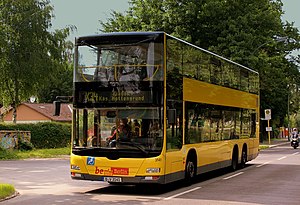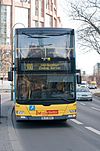Bus transport in Berlin
 | |
 MAN Lion's City DD double decker bus | |
| Overview | |
|---|---|
| Locale | Berlin, Germany |
| Transit type | Public bus transport |
| Number of lines | 329 (+39 night lines) |
| Operation | |
| Began operation | 1846 |
| Operator(s) | Berliner Verkehrsbetriebe |
| Number of vehicles | MAN Lion's City, |
| Technical | |
| System length | 1,662 km (1,033 mi) |






Bus transport is the oldest public transport service in Berlin, the capital city of Germany, having been introduced in 1846. Since 1929, services have been operated by the Berlin Transport Company (German: Berliner Verkehrsbetriebe, BVG), although during the Cold War-era division of the city they operated in West Berlin only. BVG's fleet consists of 1,300 vehicles, which cover 300,000 kilometres per day.
History[]
30 October 1846 saw the first bus services from the Concessionierte Berliner Omnibus-Compagnie. In 1868, a new company was created, the ABOAG (Allgemeinen Berliner Omnibus Actien Gesellschaft) which on 1 January 1929 merged with other Berlin public transport companies to create the BVG.
After the opening of the Berlin Wall, the transport companies were no longer able to cope with the traffic, and so once again, solo buses by other transport companies and 100 hired coaches were used. The 3-digit numbering system was unified and implemented on 2 June 1991, just before the reunification of BVG in 1 January 1992.
Routes[]
Normal buses[]
Normal bus routes (![]() )[1] make up most of the network and consist of around 300 lines, numbered from 100 to 399. The most famous line is the 100, which serves the tourist route from Alexanderplatz to the Zoological Garden passing many of Berlin's sights. The suburban buses, operating outside Berlin and not managed by BVG, are included in the tariff area of Berlin public transport.
)[1] make up most of the network and consist of around 300 lines, numbered from 100 to 399. The most famous line is the 100, which serves the tourist route from Alexanderplatz to the Zoological Garden passing many of Berlin's sights. The suburban buses, operating outside Berlin and not managed by BVG, are included in the tariff area of Berlin public transport.
Each bus line has a 3-digit number. The second digit indicates the borough in which the line runs:
- 0 = across more than 1 or 2 boroughs
- 1 = for the former boroughs of Wilmersdorf and Zehlendorf
- 2 = for the district of Reinickendorf
- 3 = for the district of Spandau
- 4 = for the districts of Mitte and Friedrichshain-Kreuzberg
- 5 = for the district of Pankow and the former one of Hohenschönhausen
- 6 = for the district of Treptow-Köpenick
- 7 = for the districts of Tempelhof-Schöneberg and Neukölln
- 8 = for the former district of Steglitz
- 9 = for the district of Marzahn-Hellersdorf and the former one of Lichtenberg
MetroBus[]
As for the MetroTram lines, there are 17 MetroBus (![]() )[2] lines, each running every 10 minutes with a 24-hour service. Unlike the other bus lines, they are shown on many tramway maps and on some railway maps of the city.
)[2] lines, each running every 10 minutes with a 24-hour service. Unlike the other bus lines, they are shown on many tramway maps and on some railway maps of the city.
The MetroBus routes are:
- M11: Dahlem-Dorf – Schöneweide
- M19: Grunewald – Mehringdamm
- M21: Rosenthal – Jungfernheide
- M27: Pankow – Jungfernheide
- M29: Grunewald – Hermannplatz
- M32: Rathaus Spandau – Dallgow-Döberitz, Havelpark
- M36 (formerly 236 and X36): Am Omnibushof – U Haselhorst
- M37: Spandau – Staaken
- M41: Sonnenallee – Hauptbahnhof
- M44: Buckow – Hermannstraße
- M45: Spandau – Zoologischer Garten
- M46: Zoologischer Garten – Britz-Süd
- M48: Zehlendorf – Alexanderplatz
- M49: Heerstraße/Nennhauser Damm – Zoologischer Garten
- M76: Walter-Schreiber-Platz – Lichtenrade
- M77: Marienfelde, Waldsassener Straße – Alt-Mariendorf
- M82: Marienfelde, Waldsassener Straße – Rathaus Steglitz
- M85: Lichterfelde Süd – Hauptbahnhof
Express bus[]
The express buses (![]() )[3] are 13 rapid lines, mainly used to reach the airports or linking the suburbs to the city centre, with far fewer stops. The most famous route is the former TXL bus line (Tegel Airport – Alexanderplatz), which ceased service after the closure of Tegel airport.
)[3] are 13 rapid lines, mainly used to reach the airports or linking the suburbs to the city centre, with far fewer stops. The most famous route is the former TXL bus line (Tegel Airport – Alexanderplatz), which ceased service after the closure of Tegel airport.
- X7: Flughafen BER – Rudow
- X10: Zoologischer Garten – Teltow, Rammrath-Brücke
- X11: Krumme Lanke – Schöneweide
- X21: Märkisches Viertel, Quickborner Straße – U Jakob-Kaiser-Platz
- X33: Märkisches Viertel, Wilhelmsruher Damm – Rathaus Spandau
- X34: Kladow – Zoologischer Garten
- X49: Staaken – Messe Nord/ICC
- X54: Pankow – Hellersdorf
- X69: Marzahn – Köpenick, Müggelschlößchenweg
- X71: U Alt-Mariendorf – Flughafen BER
- X76: Walter-Schreiber-Platz – Lichtenrade
- X83: Königin-Luise-Straße/Clayallee – Lichtenrade
Night buses[]
The night buses (N),[4] consisting of 45 lines, substitute (from N1 to N9) the U-Bahn (except at weekends). The other lines serve suburban neighbourhoods not served by any public service running in daytime.
- N1: Warschauer Straße ↔ Zoologischer Garten
- N2: Pankow ↔ Ruhleben
- N3: Wittenbergplatz ↔ Mexikoplatz
- N5: Alexanderplatz ↔ Hönow
- N6: Alt-Tegel ↔ Alt-Mariendorf
- N7: Rathaus Spandau ↔ Flughafen BER
- N8: Märkisches-Viertel ↔ Hermannstraße
- N9: Osloer Straße ↔ Rathaus Steglitz
Other services[]
Apart from the service buses managed by BVG and other local companies, in the city there are hundreds of private tourist coaches. The main bus station of Berlin is the Zentraler Omnibusbahnhof Berlin ("Central Omnibus Station"), also known as ZOB.[5] It is located in Charlottenburg-Wilmersdorf and linked to the stations of Kaiserdamm (U-Bahn) and Messe Nord/ICC[6] (S-Bahn).
In popular culture[]
On 18 February 2011 MR Software released OMSI – The Bus Simulator (also known as OMSI – Der Omnibussimulator) for Windows. It is a bus simulator set in the late 1980s in West Berlin that features the MAN SD200 and MAN SD202 double-decker buses with a complex set of functions and made in various years. The player operates these buses along line 92 (now M37) that served the Staaken, Wilhelmstadt, Altstadt, and Falkenhagener Feld localities in the borough of Spandau. On 11 December 2013, MR Software released for Windows, the sequel to OMSI – The Bus Simulator. It features the MAN NL202 and the MAN NG272 in addition to the buses featured in OMSI (MAN SD200/SD202). The player can enjoy the bus lines 5 (now 130), 92 (now M37) and other add-ons which is community developed. It is sold on , Steam and Halycon.
Fleet[]
As of 2015, the BVG bus fleet consisted of 1300 buses.
Single-decker[]
| Quantity | Manufacturer | Type | Passengers | Length | Notes | Photo |
|---|---|---|---|---|---|---|
| 77 | Mercedes-Benz | EN02 Citaro | 60–70 | 12 m | 
| |
| 9 | MAN | EN03 Lion's City A21 | 60–70 | 12 m | To be retired by 2017–2019 | 
|
| 30 | Mercedes-Benz | EN05 Citaro | 60–70 | 12 m | 
| |
| 80 | Mercedes-Benz | EN06 Citaro | 60–70 | 12 m | 
| |
| 150 | Mercedes-Benz | EN09 Citaro LE | 60–70 | 12 m | 
| |
| 2 | VDL | EN12 Citea LLE-120 | 60–70 | 12 m | 
| |
| 40 | VDL | EN15 Citea LLE-120 | 70 | 12 m | 
| |
| 4 | Solaris | EN15 Urbino 12 electric | 60–70 | 12 m | Electric bus | 
|
| 15 | Mercedes-Benz | EN19 eCitaro | 70 | 12 m | Electric bus | 
|
Lengthened bus[]
| Quantity | Manufacturer | Type | Passengers | Length | Notes | Photo |
|---|---|---|---|---|---|---|
| 67 | Mercedes-Benz | LN02 Citaro L | 15 m | 
|
Bendy bus or articulated bus[]
| Quantity | Manufacturer | Type | Passengers | Length | Notes | Photo |
|---|---|---|---|---|---|---|
| 32 | MAN | GN03 Lion's City G A23 | fewer than 99 | 18 m | To be retired by 2017–2019 | 
|
| 36 | Mercedes-Benz | GN03 Citaro G | fewer than 99 | 18 m | 
| |
| 130 | Solaris | GN05 Urbino 18 | fewer than 99 | 18 m | 6 buses have been sold to Bratislava. | 
|
| Solaris | GN07 Urbino 18 | fewer than 99 | 18 m | 
| ||
| 46 | Solaris | GN08 Urbino 18 | 99 | 18 m | 
| |
| 40 | Solaris | GN09 Urbino 18 | 99 | 18 m | 
| |
| 70[7] | Scania | GN14 Citywide LFA | 99 | 18 m | 
| |
| Scania | GN15 Citywide LFA | 99 | 18 m | 
|
Double-decker bus[]
The BVG operates some 416 double-decker buses.[8]
| Quantity | Manufacturer | Type | Passengers | Length | Notes | Photo |
|---|---|---|---|---|---|---|
| 1 | MAN | DL04 Lion's City DD | 110 | 13.7 m | 
| |
| 103 | MAN | DL05 Lion's City DD | 110 | 13.7 m | 
| |
| 103 | MAN | DL07 Lion's City DD | 110 | 13.7 m | 
| |
| 105 | MAN | DL08 Lion's City DD | 110 | 13.7 m | 
| |
| 104 | MAN | DL09 Lion's City DD | 110 | 13.7 m | 
| |
| 1 | VDL | DN15 Citea DLF 114 | 97 | 11.4 m | Prototype[9] | 
|
| 1 | Scania | DN15 Citywide LFDD | 88 | 10.9 m | Prototype[10] | 
|
| 1 | Alexander Dennis | Enviro 500 MMC | 12.9 m | Prototype (demonstration only) | 
|
Future bus[]
| Quantity | Manufacturer | Type | Passengers | Length | Notes | Photo |
|---|---|---|---|---|---|---|
| 200 | Alexander Dennis | Enviro500 MMC | 80 seated | 13.8m | Minimum 70,[11] option for 430[12] | 
|
References[]
- ^ (in German) Bus (normal lines) page on BVG website
- ^ (in German) MetroBus page on BVG website
- ^ (in German) ExpressBus page on BVG website
- ^ (in German) Night buses page on BVG website
- ^ Berlin ZOB location on Google Maps
- ^ Named Witzleben until 2002
- ^ "BVG übernimmt 70 Scania Gelenkbusse" [BVG takes delivery on 70 Scania articulated buses]. Scania (in German). Archived from the original on 4 March 2016. Retrieved 22 October 2015.
- ^ "BVG Unternehmen – Profil". BVG (in German). Berliner Verkehrsbetriebe. Retrieved 2 February 2021.
- ^ "BVG stellt neuen Doppeldeckerbus vor". BVG (in German). Berliner Verkehrsbetriebe. 11 August 2015. Retrieved 2 February 2021.
- ^ "Busflotte der BVG bekommt Zuwachs". BVG (in German). Berliner Verkehrsbetriebe. 30 January 2015. Retrieved 2 February 2021.
- ^ "Neue Doppeldecker für Berlin". BVG (in German). Berliner Verkehrsbetriebe. 22 October 2018. Retrieved 2 February 2021.
- ^ "Alexander Dennis wins Berlin contract for new double decker fleet". Alexander Dennis (in German). 22 October 2018. Retrieved 2 February 2021.
Literature[]
- Dieter Gammrath, Hein Jung: "Berliner Omnibusse". Alba, Düsseldorf 1988, ISBN 3-87094-334-3
- Gammrath, Jung, Schmiedeke: "Berliner Omnibusse". Alba, Düsseldorf 1999, ISBN 3-87094-359-9
External links[]
| Wikimedia Commons has media related to Bus transport in Berlin. |
- Transport in Berlin
- Bus transport in Germany
